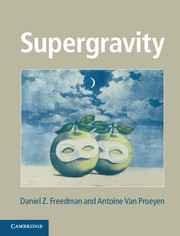Book contents
- Frontmatter
- Contents
- Preface
- Acknowledgements
- Introduction
- Part I Relativistic field theory in Minkowski spacetime
- Part II Differential geometry and gravity
- Part III Basic supergravity
- Part IV Complex geometry and global SUSY
- Part V Superconformal construction of supergravity theories
- Part VI N = 1 supergravity actions and applications
- Part VII Extended N = 2 supergravity
- Part VIII Classical solutions and the AdS/CFT correspondence
- Appendix A Comparison of notation
- Appendix B Lie algebras and superalgebras
- References
- Index
Preface
Published online by Cambridge University Press: 05 May 2012
- Frontmatter
- Contents
- Preface
- Acknowledgements
- Introduction
- Part I Relativistic field theory in Minkowski spacetime
- Part II Differential geometry and gravity
- Part III Basic supergravity
- Part IV Complex geometry and global SUSY
- Part V Superconformal construction of supergravity theories
- Part VI N = 1 supergravity actions and applications
- Part VII Extended N = 2 supergravity
- Part VIII Classical solutions and the AdS/CFT correspondence
- Appendix A Comparison of notation
- Appendix B Lie algebras and superalgebras
- References
- Index
Summary
The main purpose of this book is to explore the structure of supergravity theories at the classical level. Where appropriate we take a general D-dimensional viewpoint, usually with special emphasis on D = 4. Readers can consult the Contents for a detailed list of the topics treated, so we limit ourselves here to a few comments to guide readers. We have tried to organize the material so that readers of varying educational backgrounds can begin to read at a point appropriate to their background. Part I should be accessible to readers who have studied relativistic field theory enough to appreciate the importance of Lagrangians, actions, and their symmetries. Part II describes the differential geometric background and some basic physics of the general theory of relativity. The basic supergravity theories are presented in Part III using techniques developed in earlier chapters. In Part IV we discuss complex geometry and apply it to matter couplings in global N = 1 supersymmetry. In Part V we begin a systematic derivation of N = 1 matter-coupled supergravity using the conformal compensator method. The going can get tough on this subject. For this reason we present the final physical action and transformation rules and some basic applications in two separate short chapters in Part VI. Part VII is devoted to a systematic discussion of N = 2 supergravity, including a short chapter with the results needed for applications. Two major applications of supergravity, classical solutions and the AdS/CFT correspondence, are discussed in Part VIII in considerable detail. It should be possible to understand these chapters without full study of earlier parts of the book.
- Type
- Chapter
- Information
- Supergravity , pp. xv - xviPublisher: Cambridge University PressPrint publication year: 2012



